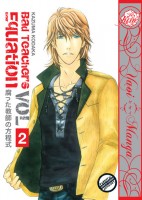My News and Reviews
There were two in-depth reviews posted at Experiments in Manga Last week. The first review was of Torajiro Kishi’s manga Maka-Maka: Sex, Life, and Communication, Volume 1 as a part of my Year of Yuri review project. Maka-Maka is definitely a mature title and there’s quite a bit of sex and physical intimacy, but I think it’s one of the best adult-oriented yuri manga to have been released in English. Sadly, it’s very out-of-print. The second review was of The Black Lizard and Beast in the Shadows, a collection of two of Edogawa Rampo’s better known short novels of suspense. I though they were pretty great, but then again I tend to be rather fond of Rampo’s works.
As for a few other interesting things: Jason Thompson takes a look at the mahjong manga The Legend of Koizumi in the most recent House of 1000 Manga column. (Ed Chavez apparently wanted to license the series. It’s unlikely to ever actually happen, but we can dream!) Yen Press had quite a few license announcements of its own to make, including the establishment Yen On, an imprint specifically devoted to light novels. Dark Horse also announced some exciting licenses—more manga by CLAMP and Satoshi Kon. Toh EnJoe won the Philip K. Dick Award Special Citation for his work Self-Reference Engine, one of my favorite books released last year. And speaking of awards, the 2014 Eisner Award Nominees have been announced. Manga up for an Eisner Award include The Heart of Thomas, The Mysterious Underground Men, Showa: A History of Japan, 1926–1939, The Summit of the Gods, Volume 4, and Utsubora: The Story of a Novelist in the Best U.S. Edition of International Material—Asia category and The Strange Tale of Panorama Island in the category for Best Adaptation from Another Medium.
Quick Takes
 Bad Teacher’s Equation, Volumes 4-5 by Kazuma Kodaka. Bad Teacher’s Equation has come a long way since its first volume. The series was nearly a decade in the making, so it probably shouldn’t be too surprising that it underwent some significant evolution in both artwork and storytelling, including some unexpected plot developments. In the series’ afterword, Kodaka notes that Bad Teacher’s Equation “mirrored the history of boy’s love comics throughout the ’90s” and that it was her first foray into the genre. It started out as a comedy, but by the end of the series, while there is still a fair amount of humor, it has become much more serious and even addresses some of the challenges that face same-sex couples in a more realistic fashion. I particularly enjoyed the fourth volume because of this and because of its focus on Masami and Toru’s relationship. They are the most consistently believable couple in Bad Teacher’s Equation. Although I wasn’t always convinced by Masayoshi and Atsushi’s relationship in the series, for the most part I did really like how things played out for them in the final volume.
Bad Teacher’s Equation, Volumes 4-5 by Kazuma Kodaka. Bad Teacher’s Equation has come a long way since its first volume. The series was nearly a decade in the making, so it probably shouldn’t be too surprising that it underwent some significant evolution in both artwork and storytelling, including some unexpected plot developments. In the series’ afterword, Kodaka notes that Bad Teacher’s Equation “mirrored the history of boy’s love comics throughout the ’90s” and that it was her first foray into the genre. It started out as a comedy, but by the end of the series, while there is still a fair amount of humor, it has become much more serious and even addresses some of the challenges that face same-sex couples in a more realistic fashion. I particularly enjoyed the fourth volume because of this and because of its focus on Masami and Toru’s relationship. They are the most consistently believable couple in Bad Teacher’s Equation. Although I wasn’t always convinced by Masayoshi and Atsushi’s relationship in the series, for the most part I did really like how things played out for them in the final volume.
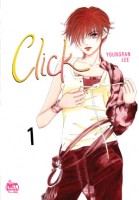 Click, Volumes 1-4 by Youngran Lee. The basic premise of Click is fairly absurd—Joonha’s family has a strange genetic mutation which causes their bodies to change sex shortly after they reach puberty. Of course, this was never actually mentioned to Joonha and so he’s understandable concerned when at the age of sixteen all of a sudden he seems to have turned into a girl. At first, I thought that Click was going to be a comedy, but that’s not entirely the case. There are humorous elements, Joonha’s parents, for example, are a rather unusual pair and their scenes are generally played for laughs, but the manhwa is much more about the drama (and melodrama). It might not be the most realistic series, but there’s actually some interesting exploration of gender, gender roles, and gender identity in Click. Joonha isn’t a particularly pleasant person and on top of that he’s a misogynistic jerk, too. His sex change is a rather traumatic event for him and he’s now stuck in between genders. His body is female, and he tries to live as a girl, but his personality and way of thinking hasn’t really changed that much.
Click, Volumes 1-4 by Youngran Lee. The basic premise of Click is fairly absurd—Joonha’s family has a strange genetic mutation which causes their bodies to change sex shortly after they reach puberty. Of course, this was never actually mentioned to Joonha and so he’s understandable concerned when at the age of sixteen all of a sudden he seems to have turned into a girl. At first, I thought that Click was going to be a comedy, but that’s not entirely the case. There are humorous elements, Joonha’s parents, for example, are a rather unusual pair and their scenes are generally played for laughs, but the manhwa is much more about the drama (and melodrama). It might not be the most realistic series, but there’s actually some interesting exploration of gender, gender roles, and gender identity in Click. Joonha isn’t a particularly pleasant person and on top of that he’s a misogynistic jerk, too. His sex change is a rather traumatic event for him and he’s now stuck in between genders. His body is female, and he tries to live as a girl, but his personality and way of thinking hasn’t really changed that much.
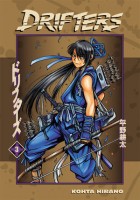 Drifters, Volume 3 by Kohta Hirano. I’m still not sure that I entirely understand what the underlying plot of Drifters is supposed to be, but I’m not entirely certain that it matters much at this point, either. At least not to me. I enjoy Drifters for the series’ outrageous characters and battles more than any sort of coherent story. I also appreciate Hirano’s use of historic figures in the series, although it does help to have at least some vague idea of who they are outside of the manga. Admittedly, Hirano’s interpretations are extraordinarily liberal and irreverent. Most of the characters exhibit varying degrees of insanity and there’s not much subtlety or nuance to their characterizations, either. So far, Drifters has been a very violent series. The third volume is no exception to this and battle after battle is fought. I have noticed some continuity errors in the artwork which can be distracting or confusing, especially when they occur in the middle of a fight scene. (Past volumes had this same problem, too.) In the end, Drifters still doesn’t make much sense yet, but I continue to find it to be highly entertaining.
Drifters, Volume 3 by Kohta Hirano. I’m still not sure that I entirely understand what the underlying plot of Drifters is supposed to be, but I’m not entirely certain that it matters much at this point, either. At least not to me. I enjoy Drifters for the series’ outrageous characters and battles more than any sort of coherent story. I also appreciate Hirano’s use of historic figures in the series, although it does help to have at least some vague idea of who they are outside of the manga. Admittedly, Hirano’s interpretations are extraordinarily liberal and irreverent. Most of the characters exhibit varying degrees of insanity and there’s not much subtlety or nuance to their characterizations, either. So far, Drifters has been a very violent series. The third volume is no exception to this and battle after battle is fought. I have noticed some continuity errors in the artwork which can be distracting or confusing, especially when they occur in the middle of a fight scene. (Past volumes had this same problem, too.) In the end, Drifters still doesn’t make much sense yet, but I continue to find it to be highly entertaining.
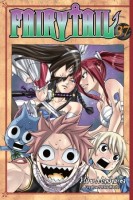 Fairy Tail, Volume 37 by Hiro Mashima. It’s the final day of the Grand Magic Games, the results of which will literally determine the fate of the world. The danger of course is that Mashima may have over-hyped the Games’ finale; the victory of the guild that ultimately wins is described as being impossible and highly unusual. But if there’s going to be a tournament arc, that’s certainly one way of making it crucial to the development of the story. I consider it to be a good thing. While the Grand Magic Games were diverting, for a while there they didn’t seem to have much of a point except to serve as an excuse to have high-powered wizards doing battle. And there’s plenty of fighting in the thirty-seventh volume, including several confrontations that occur simultaneously. Sadly, compared to previous battles, I didn’t find them to be especially engaging. The most interesting fight is the one between Erza and two other extremely skilled and strong women, Kagura and Minerva, which has several scenes which are particularly dramatic. Mashima does have to cheat and mislead readers with the artwork a bit to achieve some of those moments, though.
Fairy Tail, Volume 37 by Hiro Mashima. It’s the final day of the Grand Magic Games, the results of which will literally determine the fate of the world. The danger of course is that Mashima may have over-hyped the Games’ finale; the victory of the guild that ultimately wins is described as being impossible and highly unusual. But if there’s going to be a tournament arc, that’s certainly one way of making it crucial to the development of the story. I consider it to be a good thing. While the Grand Magic Games were diverting, for a while there they didn’t seem to have much of a point except to serve as an excuse to have high-powered wizards doing battle. And there’s plenty of fighting in the thirty-seventh volume, including several confrontations that occur simultaneously. Sadly, compared to previous battles, I didn’t find them to be especially engaging. The most interesting fight is the one between Erza and two other extremely skilled and strong women, Kagura and Minerva, which has several scenes which are particularly dramatic. Mashima does have to cheat and mislead readers with the artwork a bit to achieve some of those moments, though.
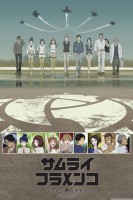 Samurai Flamenco directed by Takahiro Omori. Samurai Flamenco is an anime series that celebrates superheros and superhero shows. It uses a strange mix of silliness bordering on parody and seriousness, but it somehow works. Samurai Flamenco begins very realistically, with Hazama acting as a vigilante. He’s not particularly competent at first, but he makes up for that with his enthusiasm, passion, and belief in justice. It also helps that other people are drawn to him and his cause. On the surface, the middle portion of the series seems like a very typical superhero show with monsters and evil organizations. The villains’ character designs are frankly ridiculous. But then the anime returns to a more serious approach and the final episode pulls everything together perfectly. I did enjoy the humor of the series but I probably appreciated the more realistic examination of what it means to be a superhero even more. I quite enjoyed Samurai Flamenco and found the characters, all of whom are just a little bit strange, to be both likeable and interesting.
Samurai Flamenco directed by Takahiro Omori. Samurai Flamenco is an anime series that celebrates superheros and superhero shows. It uses a strange mix of silliness bordering on parody and seriousness, but it somehow works. Samurai Flamenco begins very realistically, with Hazama acting as a vigilante. He’s not particularly competent at first, but he makes up for that with his enthusiasm, passion, and belief in justice. It also helps that other people are drawn to him and his cause. On the surface, the middle portion of the series seems like a very typical superhero show with monsters and evil organizations. The villains’ character designs are frankly ridiculous. But then the anime returns to a more serious approach and the final episode pulls everything together perfectly. I did enjoy the humor of the series but I probably appreciated the more realistic examination of what it means to be a superhero even more. I quite enjoyed Samurai Flamenco and found the characters, all of whom are just a little bit strange, to be both likeable and interesting.

